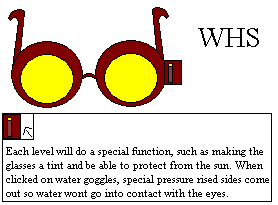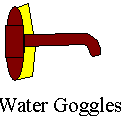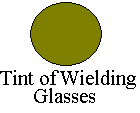
Past
Around 1,000 years ago, few people were able to read or write. Most of these people were monks. As they grew older, reading and writing became very difficult becuase there was very few light. So this is when the monks began to make "Reading Stones". "Reading Stones" were a section of a spherical clear and plolished natural Glass, usually quartz.
Through many times of trying, the monks realized something about the "Reading Stones". Larger stones would give less maginification than smallers stones and the flat part of the stone did not have to be the middle of the sphere.
Eyeglasses for reading have a special function. They can move to the focal point from the behind the retina onto the retina itself. There glasses were only for correcting close distance vision.
Master-Glassmakers in Venice began making spectacles around the end of the 13th century. The spectacles were really just two magnifying lenses connected by a hinge.
The introduction of the concave lenses in eyeglasses, in the 15th and 16th centuries, solved the problem of nearsightedness .These lenses move the focal point from the front of the retina onto the retina itself.
In the 17th century, one of the major problems for the eyeglasses was how to keep them on. One solution was to have some string or ribbons attached to the lenses and the loop them over the ears.
The side temples were invented in the 18th century and have stuck with us for centuries. Later in the 18th century, temples with sliding extension were introduced in Europe.
Also in the 18th century, Benjamin Franklin develops eyeglasses for distance and close vision. This was when he invented the bifocal eyeglasses. He was getting tired of switching out glasses for distance and close vision.
In the 19th century, cylindrical lenses to correct Astigmatism were introduced and the monocle (one lens) became very popular, mostly in Germany. At the end of the 19th century, pinch-nose eyeglasses worked very well because of its convenience.
Early in the 20th century, the frames of an eyeglass began to be designed with fashion in mind.
Present
It seems not many people wear eyeglasses anymore. Laser Eye Correction Surgery and contact lenses have become in more of a popular choice than eyeglasses. It seems now people wear glasses to protect there eyes.
Sunglasses are glasses that are tinted some to help block the UV-Rays from the sun going directly into your eyes and hurting them. Sunglasses reduce the glare and therefore, making you able to see your surroundings better. Sunglasses that patrol officers wear make them able to see a speeding car go by easily. One problem with sunglasses are that some of the sunglass makers make them very poorly.
Welders wear glasses with a darker tint than sunglasses to help with the rays of welding flames. The tint of the glass depends on the job. Welding produces hot metal which makes alot of infrared radiation. Arc welding produces large amounts of ultraviolet light. For that reason, the absorption of welding glasses isn't limited to visible light, but is carefully extended into the infrared (unlike sunglasses) and ultraviolet. Also, some astronomers sometimes use a shade 14 welding glass to view the sun with the naked eye.
Alot of construction workers wear safety glasses to help protect them from flying particles. This helps reduce an injury to the eye.
Avators and car racers wear goggles in order to protect their eyes from particles in the wind and the wind itself. When a car racer is going fast, alot of particles could be floating in the air and if that racer does not have the goggles on, he could be blinded and cause injury.
Divers wear watertight goggles to stop water coming in onto their eyes during a dive. This helps the diver because the diver is able to see at normal vision (unless its dark) and nothing can damage their eyes.
Future
The future is coming for glasses. Although eyeglasses are fading away as contact lenses and laser eye surgery are taking over, that doesnt mean it can take over regular glasses. And that is what Mr. DeVaul also thought.
Dr. DeVaul has invited the Memory Glasses. A small computer display mounted on eyeglass frames and wired to a lightweight computer will flash reminders to the wearer, without distraction with regular activities. The wearable computer will basically give subliminal messages or images that would flash on the screen. Although the prompts would be too quick for the wearer to notice anything, the brain would recognize it and respond.

Ideas and Designs
Well, Dexter and I have come up with something that will be soo hi-tech that it would revolunize the world of glasses. We didn't want to copy the design we found in our Future section. After both of us looked at what the present state of glasses is at, we figure that if we put all the different glasses together, it would make a pair of super glasses. So using paint, we have designed a rough picture of what it would look like.


This shows how the sealing around the glasses are when in water goggles mode

What color the glasses are in the sunglass mode

In the weilding mode, the glasses are more of a darker tint to help keep the eyes protected

When in safety glasses, the glass is 4 layers thick and can take an impact of 50 lbs.
What must be done
We have figured that for us to get to where we need to be in the future, we must always remember to think and ask questions. If we never think of another thing to help improve society, then we will put a dead stop on the advancement of modern life. And we must always ask questions. The only dumb question is a question never asked. If we want to know something, we should ask. This will improve our knowledge
We beleive that if we ever wanted a real type glasses like the one Dexter and I designed, then we must think of how the control would work, how the goggles would come in and out, how the other 3 layers of the safety goggles come out, and more all to fit comfortably on the person's head. So we think that it would most likely be made of metal and lots of mechanics would be in the glasses so everything works properly and fits the comfront standards of an average human.
Bibliography
"Eyeglasses." Microsoft Encarta.Redmond, WA: Microsoft 2002.
I4U.The Future: Memory Glasses from the MIT BorgLab. January 10, 2004.
i4ULENSES. History of Glasses. January 10, 2004.
Planet Glasses. History of Sunglasses. January 10, 2004.
Sizes. Welding Glasses. January 10, 2004.